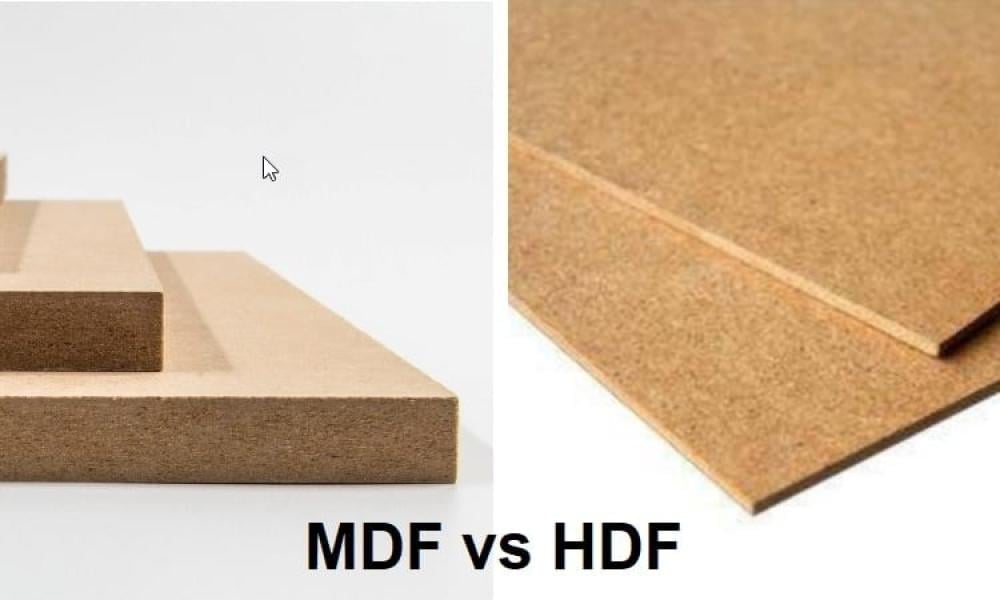In the world of furniture and interior design, there are many types of wood used, each with its own characteristics and features that make it suitable for specific uses.
Among these types, two popular types are HDF and MDF .
These two materials may look similar at first glance, but there are fundamental differences between them that affect their strength and durability, and therefore each has its own uses.
To avoid confusion, as leaders in the world of interior design, we'll help you understand the difference between HDF and MDF . We'll answer common questions like: Is HDF stronger than MDF? What are the disadvantages of MDF? We'll help you make the best decisions when choosing materials for your projects.
What does HDF mean and what does MDF mean?
To fully understand the difference between HDF and MDF , it's important to first understand what HDF means and what MDF means.
- MDF (Medium-Density Fiberboard): Medium-density fiberboard is manufactured by breaking down softwood or hardwood scraps into fine fibers, mixing them with glue and resins, and applying high heat and pressure to form a homogeneous board. The density of MDF typically ranges between 600 and 800 kg/m³.
- HDF (High-Density Fiberboard): This is a high-density fiberboard, similar in manufacturing process to MDF, except that it uses finer fibers and much higher pressure and heat. This results in a denser, stiffer board. The density of HDF boards is typically higher than 800 kg/m³ and can reach 1,000 kg/m³ or more.
Is HDF stronger than MDF?
The short answer is yes, HDF is stronger than MDF .
The higher density of HDF wood makes it more rigid and resistant to bending, pressure, and shock than MDF.
This means that furniture or flooring made of HDF will generally be more durable and able to withstand heavy use.
Additionally, HDF is less susceptible to moisture damage than MDF, although it is still not recommended for direct use in humid environments without proper treatment.
Advantages and disadvantages of HDF wood
For a deeper understanding of the advantages and disadvantages of HDF wood , here is a detailed look:
Features:
- High Strength and Durability: High density makes HDF strong and resistant to abrasion, scratches and shocks.
- Dimensional Stability: Less susceptible to expansion and contraction from temperature and humidity changes than MDF and natural wood.
- Smooth Surface: Provides an excellent surface for various finishes such as paints, veneers, and melamine.
- Ease of fabrication and shaping: It can be easily cut and shaped using standard woodworking tools.
- Versatile uses: Used in the manufacture of flooring (parquet), doors, high-quality furniture, and HDF wood for kitchens (with moisture-resistant treatment).
Disadvantages:
- Higher cost: HDF is typically more expensive than MDF due to the more complex manufacturing process and the use of higher quality raw materials.
- Heavier Weight: The high density makes HDF boards heavier than MDF, which can be a disadvantage in some applications.
- Difficulty in installation in some cases: Due to its rigidity, installing HDF using traditional nails may be more difficult and require stronger tools or special nails.
MDF wood advantages and disadvantages
To understand the other side of the comparison, here are the advantages and disadvantages of MDF wood :
Features:
- Lower cost: MDF is generally less expensive than HDF and natural wood, making it an economical choice for many applications.
- Smooth, flat surface: Provides an excellent surface for paints, veneers, and melamine, resulting in high-quality finishes.
- Ease of fabrication and shaping: It can be easily cut, drilled and shaped without breaking or splintering.
- Uniformity of texture: It does not contain knots or natural defects found in natural wood.
- Versatile Uses: Widely used in home and office furniture, shelves, interior doors, and cabinets.
Disadvantages:
- Lower strength and durability: Less rigidity and resistance to bending, compression and shock compared to HDF and natural wood.
- Moisture sensitivity: It readily absorbs moisture, swelling, and deteriorating, making it unsuitable for use in humid environments such as bathrooms and kitchens without special treatment. This is one of the most significant disadvantages of MDF .
- Heavier than some natural woods: Although it is lighter than HDF, it may be heavier than some lightweight natural woods.
- Possibility of edge damage: MDF edges are more susceptible to damage and cracking when exposed to repeated impact.
Optimal uses of HDF and MDF wood
Understanding the difference between HDF and MDF is crucial, and it depends on your needs. Are you looking to buy some furniture for your home, or are you looking for a high-end wooden floor?
Here is the optimal use of each type:
Best uses of HDF wood
HDF wood is characterized by its high density, strength, and durability, making it the ideal choice for applications requiring high endurance and resistance to corrosion. Its most prominent uses include:
- Flooring: High quality parquet flooring that can withstand heavy traffic.
- Doors: Interior and exterior doors that need strength and stability.
- High-quality furniture: Office and hotel furniture that requires extreme durability.
- Kitchens: HDF wood doors and facades for kitchens (with the need for appropriate treatment to resist moisture).
Best uses of MDF wood
In contrast, MDF is economical, easy to work, and has a smooth surface ideal for painting and veneering. Therefore, its ideal uses include:
- Home and office furniture: Furniture with intricate designs that are not exposed to high humidity.
- Shelves and internal cabinets: storage solutions in dry environments.
- Interior doors: in places not exposed to direct moisture.
- Furniture components: drawer bases and furniture back panels.
- Interior decorations: decorative items and prototypes due to its ease of cutting and carving.
Comparison between MDF and some other types of wood
The difference between MDF and HPL wood
The difference between MDF and HPL is that MDF is the base material (fiberboard), while HPL (High-Pressure Laminate) is a type of finish or veneer applied to the surface of MDF or any other material. HPL consists of layers of resin-impregnated paper pressed under high heat and pressure, resulting in a durable surface that is resistant to scratches, moisture, and heat. HPL is often used to cover kitchen countertops and furniture to increase their durability and visual appeal.
The difference between MDF and high gloss
The difference between MDF and high gloss is similar to the difference between MDF and HPL.
MDF is the base material, while "high gloss" is a type of finish applied to the surface of MDF or any other material. A high gloss finish features a shiny, reflective surface, giving the furniture a modern, elegant appearance. This finish can be achieved using various types of paints or glossy veneers.
Which is better, MDF or engineered wood?
When comparing which is better, MDF or engineered wood, it's important to understand that "engineered wood" is a broad term that encompasses various types of manufactured wood, including MDF, HDF, plywood, and more. Each type of engineered wood has its own characteristics and uses. In general:
- MDF: It is a good choice for interior furniture and surfaces that require a smooth finish and where exposure to moisture is limited.
- HDF: It is a better choice for applications that require higher strength, durability, and greater wear resistance, such as parquet flooring , doors, and high-quality furniture.
- Plywood: It is characterized by its high strength and better moisture resistance than MDF, making it suitable for structural uses and furniture that may be exposed to some moisture.
There is no absolute "best"; the choice depends on the specific needs of the project and the available budget.
Ultimately, understanding the difference between HDF and MDF and the advantages and disadvantages of HDF and MDF wood enables you to make informed decisions when choosing materials for your projects.
If you are looking for high strength, durability, and the ability to withstand heavy use, HDF may be the better choice despite its higher cost.
However, if you are confident that the wood will not be exposed to moisture and will not be used extensively, you may not need to pay a high price. MDF may be an economical and practical option.
For more information about wood types, their uses, and the best quality decorations, you can browse our website .

